Predicting Airline Customer Loyalty by Integrating Structural Equation Modeling and Bayesian Networks
Abstract
1. Introduction
2. Literature Review
3. Methodology
3.1. Participants and Data Collection
3.2. Measurement Instruments
3.3. Analysis
4. Results
4.1. Linking SEM to BN
4.2. Network Validation and Robustness Test
4.3. Sensitivity Analysis
5. Scenario Analysis
5.1. Scenario 1: Effect of Customer Satisfaction
5.2. Scenario 2: Effect of Customer Trust
5.3. Scenario 3: Effect of Perceived Value
5.4. Scenario 4: Effect of Customer Satisfaction, Customer Trust, and Perceived Value
5.5. Scenario 5: Maximize Customer Loyalty
6. Discussion
6.1. Theoretical Contributions
6.2. Practical Implications
6.3. Limitation
7. Conclusions
Author Contributions
Funding
Institutional Review Board Statement
Informed Consent Statement
Data Availability Statement
Conflicts of Interest
Appendix A
| Variable | Measurement Items | SD | SK | KU | |
|---|---|---|---|---|---|
| Customer Loyalty (α = 0.910) | |||||
| CL1 | Word of mouth | 5.70 | 0.88 | −0.43 | −0.20 |
| CL2 | Identification | 5.50 | 1.02 | −0.79 | 1.33 |
| CL3 | Repurchase | 5.70 | 0.91 | −0.60 | 0.40 |
| Customer Satisfaction (α = 0.924) | |||||
| CS1 | Happy to use this airline’s service | 5.63 | 1.00 | −0.56 | 0.33 |
| CS2 | Overall satisfaction with airline’s service | 5.70 | 0.96 | −0.62 | 0.42 |
| CS3 | Received service quality higher than expected | 5.63 | 1.03 | −0.62 | 0.44 |
| CS4 | Received service quality was ideal | 5.55 | 1.11 | −0.86 | 1.35 |
| Customer Trust (α = 0.937) | |||||
| CT1 | Always trust this airline | 5.59 | 1.07 | −0.81 | 1.24 |
| CT2 | The airline’s good handling achieved satisfaction | 5.62 | 1.06 | −0.73 | 0.87 |
| CT3 | Reliability of the airline | 5.64 | 1.03 | −0.70 | 0.87 |
| CT4 | This airline supplied the best service | 5.50 | 1.10 | −0.81 | 1.27 |
| CT5 | This airline is stable and reliable | 5.62 | 1.05 | −0.75 | 0.92 |
| Perceived Value (α = 0.910) | |||||
| PV1 | The received service was worth its cost | 5.64 | 0.98 | −0.60 | 0.56 |
| PV2 | Provided service was reasonable compared to its cost | 5.67 | 0.96 | −0.69 | 0.73 |
| PV3 | Traveling with this airline was worth its cost | 5.65 | 0.98 | −0.72 | 0.72 |
| Perceived Service Quality (α = 0.927) | |||||
| PQ1 | Airline operation | 5.85 | 0.70 | −0.48 | 0.02 |
| PQ2 | Ground services | 5.88 | 0.78 | −0.56 | 0.63 |
| PQ3 | Information | 5.82 | 0.78 | −0.44 | −0.03 |
| PQ4 | Flight attendants | 5.98 | 0.67 | −0.45 | −0.04 |
| PQ5 | Airline tangible | 5.80 | 0.73 | −0.39 | 0.23 |
| Customer Expectation (α = 0.944) | |||||
| EQ1 | Airline operation | 6.07 | 0.70 | −0.50 | −0.37 |
| EQ2 | Flight attendants | 6.15 | 0.68 | −0.59 | −0.42 |
| EQ3 | Ground services | 6.09 | 0.75 | −0.50 | −0.55 |
| EQ4 | Information | 6.03 | 0.73 | −0.43 | −0.46 |
| EQ5 | Airline tangible | 6.08 | 0.72 | −0.60 | −0.24 |
| Customer Commitment (α = 0.908) | |||||
| CC1 | Better personal image when traveling with this airline | 5.32 | 1.17 | −0.52 | 0.09 |
| CC2 | Concern about airline’s long-term success | 5.29 | 1.16 | −0.43 | −0.06 |
| CC3 | Proud to use this airline | 5.25 | 1.17 | −0.32 | −0.21 |
| Airline Image (α = 0.914) | |||||
| AI1 | This airline has a good image in passengers’ minds | 5.78 | 0.95 | −0.69 | 0.19 |
| AI2 | I am always very impressed with this airline | 5.75 | 0.96 | −0.56 | −0.14 |
| AI3 | I trust that this airline has a better image than others | 5.63 | 1.02 | −0.84 | 1.10 |
References
- Civil Aviation Authority of Thailand. State of Thai Aviation Industry 2019; The Civil Aviation Authority of Thailand: Bangkok, Thailand, 2019; Available online: https://www.caat.or.th/wp-content/uploads/2020/06/STATE-OF-THAI-AVIATION-INDUSTRY-2019.pdf (accessed on 18 February 2021).
- Pisa, N. Causal Relationship between Air Transport, Tourism and Economic Growth: Joinpoint Regression and Granger Causality Analysis. Euro. Econ. 2018, 37, 164–176. [Google Scholar]
- Park, J.; Kim, J. The Impact of Airport Managerial Type and Airline Market Share on Airport Efficiency. Sustainability 2021, 13, 981. [Google Scholar] [CrossRef]
- Aktar, M.A.; Alam, M.M.; Al-Amin, A.Q. Global Economic Crisis, Energy Use, CO2 Emissions, and Policy Roadmap Amid COVID-19. Sustain. Prod. Consum. 2020, 26, 770–781. [Google Scholar] [CrossRef] [PubMed]
- Ozili, P.K. Covid-19 pandemic and economic crisis: The Nigerian experience and structural causes. J. Econ. Adm. Sci. 2020. [Google Scholar] [CrossRef]
- Moon, H.G.; Lho, H.L.; Han, H. Self-check-in kiosk quality and airline non-contact service maximization: How to win air traveler satisfaction and loyalty in the post-pandemic world? J. Travel Tour. Mark. 2021, 38, 383–398. [Google Scholar] [CrossRef]
- Monmousseau, P.; Marzuoli, A.; Feron, E.; Delahaye, D. Impact of Covid-19 on passengers and airlines from passenger measurements: Managing customer satisfaction while putting the US Air Transportation System to sleep. Transp. Res. Interdiscip. Perspect. 2020, 7, 1–11. [Google Scholar] [CrossRef]
- Kumar, A. Impact of Covid-19 and what needs to be done. Econ. Political Wkly. 2020, 55, 10–12. [Google Scholar]
- Gilbert, D.; Wong, R.K. Passenger expectations and airline services: A Hong Kong based study. Tour. Manag. 2003, 24, 519–532. [Google Scholar] [CrossRef]
- Hussain, R.; Al Nasser, A.; Hussain, Y.K. Service quality and customer satisfaction of a UAE-based airline: An empirical investigation. J. Air Transp. Manag. 2015, 42, 167–175. [Google Scholar] [CrossRef]
- Song, H.; Ruan, W.; Park, Y. Effects of service quality, corporate image, and customer trust on the corporate reputation of airlines. Sustainability 2019, 11, 3302. [Google Scholar] [CrossRef]
- Curry, N.; Gao, Y. Low-cost airlines—A new customer relationship an analysis of service quality, service satisfaction, and customer loyalty in a low-cost setting. Serv. Mark. Q. 2012, 33, 104–118. [Google Scholar] [CrossRef]
- Feng, Y., Jr.; Zhang, X., Jr. The Impact of Customer Relationship Marketing Tactics on Customer Loyalty Within Swedish Mobile Telecommunication Industry; Halmstad University: Halmstad, Sweden, 2009. [Google Scholar]
- Hossain, M.Z.; Kibria, H.; Farhana, S. Do Customer Loyalty Programs Really Work in Airlines Business?—A Study on Air Berlin. J. Serv. Sci. Manag. 2017, 10, 360–375. [Google Scholar]
- Serrano, F.; Kazda, A. The future of airport post COVID-19. J. Air Transp. Manag. 2020, 89, 1–10. [Google Scholar] [CrossRef]
- Agrawal, A. Sustainability of airlines in India with Covid-19: Challenges ahead and possible way-outs. J. Revenue Pricing Manag. 2020, 1–16. [Google Scholar] [CrossRef]
- Akamavi, R.K.; Mohamed, E.; Pellmann, K.; Xu, Y. Key determinants of passenger loyalty in the low-cost airline business. Tour. Manag. 2015, 46, 528–545. [Google Scholar] [CrossRef]
- Al-Refaie, A.; Bata, N.; Eteiwi, D.; Jalham, I. Examining Factors that Affect Passenger’s Overall Satisfaction and Loyalty: Evidence from Jordan Airport. Jordan J. Mech. Ind. Eng. 2014, 8, 94–101. [Google Scholar]
- Calisir, N.; Basak, E.; Calisir, F. Key drivers of passenger loyalty: A case of Frankfurt–Istanbul flights. J. Air Transp. Manag. 2016, 53, 211–217. [Google Scholar] [CrossRef]
- Salah, M.; Abou-Shouk, M.A. The effect of customer relationship management practices on airline customer loyalty. J. Tour. Herit. Serv. Mark. 2019, 5, 11–19. [Google Scholar]
- Vlachos, I.; Lin, Z. Drivers of airline loyalty: Evidence from the business travelers in China. Transp. Res. Part. E Logist. Transp. Rev. 2014, 71, 1–17. [Google Scholar] [CrossRef]
- Chonsalasin, D.; Jomnonkwao, S.; Ratanavaraha, V. Key determinants of airline loyalty modeling in Thailand. Sustainability 2020, 12, 4165. [Google Scholar] [CrossRef]
- Rahim, A.G. Perceived service quality and customer loyalty: The mediating effect of passenger satisfaction in the Nigerian Airline Industry. Int. J. Manag. Econ. 2016, 52, 94–117. [Google Scholar] [CrossRef]
- Rizan, M. Analysis of service quality and customer satisfaction, and its influence on customer loyalty. Iberia 2010, 60, 15. [Google Scholar]
- Anuwichanont, J. The impact of price perception on customer loyalty in the airline context. J. Bus. Econ. Res. 2011, 9, 37–50. [Google Scholar] [CrossRef][Green Version]
- Hwang, Y.Y.; Choi, S.-A.; Na, K.-J.; Kim, H.-J. The effect of airline service encounter quality on customer loyalty. J. Korea Ind. Inf. Syst. Res. 2014, 19, 73–85. [Google Scholar] [CrossRef]
- Pearson, S. Building Brands Directly: Creating Business Value from Customer Relationships; Springer: London, UK, 2016. [Google Scholar]
- Blackwell, S.A.; Szeinbach, S.L.; Barnes, J.H.; Garner, D.W.; Bush, V. The antecedents of customer loyalty: An empirical investigation of the role of personal and situational aspects on repurchase decisions. J. Serv. Res. 1999, 1, 362–375. [Google Scholar] [CrossRef]
- Curtis, T.; Abratt, R.; Rhoades, D.L.; Dion, P. Customer loyalty, repurchase and satisfaction: A meta-analytical review. J. Consum. Satisf. Dissatisfaction Complain. Behav. 2011, 24, 1–26. [Google Scholar]
- Etemad-Sajadi, R.; Way, S.A.; Bohrer, L. Airline passenger loyalty: The distinct effects of airline passenger perceived pre-flight and in-flight service quality. Cornell Hosp. Q. 2016, 57, 219–225. [Google Scholar] [CrossRef]
- Namukasa, J. The influence of airline service quality on passenger satisfaction and loyalty: The case of Uganda airline industry. TQM J. 2013, 25, 520–532. [Google Scholar] [CrossRef]
- Yunus, N.S.N.M.; Bojei, J.; Rashid, W.E.W. Service quality towards customer loyalty in malaysia’s domestic low cost airline services. Int. J. E-Educ. E-Bus. E-Manag. E-Learn. 2013, 3, 333. [Google Scholar]
- Baumann, C.; Hoadley, S.; Hamin, H.; Nugraha, A. Competitiveness vis-à-vis service quality as drivers of customer loyalty mediated by perceptions of regulation and stability in steady and volatile markets. J. Retail. Consum. Serv. 2017, 36, 62–74. [Google Scholar] [CrossRef]
- Dharmesti, M.D.D.; Nugroho, S.S. The antecedents of online customer satisfaction and customer loyalty. J. Bus. Retail. Manag. Res. 2013, 7, 1–12. [Google Scholar]
- Roghanian, P.; Gheysari, H. Commitment and customer loyalty in business-to-business context. Commitment 2013, 5, 156–164. [Google Scholar]
- Griffin, J. Customer Loyalty: How to Earn It, How to Keep It; Jossey-Bass: San Francisco, CA, USA, 2002. [Google Scholar]
- Wu, J.-J.; Tsang, A.S. Factors affecting members’ trust belief and behaviour intention in virtual communities. Behav. Inf. Technol. 2008, 27, 115–125. [Google Scholar] [CrossRef]
- Eisingerich, A.B.; Bell, S.J. Perceived service quality and customer trust: Does enhancing customers’ service knowledge matter? J. Serv. Res. 2008, 10, 256–268. [Google Scholar] [CrossRef]
- Morgan, R.M.; Hunt, S.D. The commitment-trust theory of relationship marketing. J. Mark. 1994, 58, 20–38. [Google Scholar] [CrossRef]
- Lin, R.-J.; Chen, R.-H.; Shun Chiu, K.K. Customer relationship management and innovation capability: An empirical study. Ind. Manag. Data Syst. 2010, 110, 111–133. [Google Scholar] [CrossRef]
- Leong, L.-Y.; Hew, T.-S.; Lee, V.-H.; Ooi, K.-B. An SEM–artificial-neural-network analysis of the relationships between SERVPERF, customer satisfaction and loyalty among low-cost and full-service airline. Expert Syst. Appl. 2015, 42, 6620–6634. [Google Scholar] [CrossRef]
- Chang, Y.-W.; Chang, Y.-H. Does service recovery affect satisfaction and customer loyalty? An empirical study of airline services. J. Air Transp. Manag. 2010, 16, 340–342. [Google Scholar] [CrossRef]
- Bejou, D.; Palmer, A. Service failure and loyalty: An exploratory empirical study of airline customers. J. Serv. Mark. 1998, 12, 7–22. [Google Scholar] [CrossRef]
- Bendapudi, N.; Berry, L.L. Customers’ motivations for maintaining relationships with service providers. J. Retail. 1997, 73, 15–37. [Google Scholar] [CrossRef]
- McAlexander, J.H.; Kaldenberg, D.O.; Koenig, H.F. Service quality measurement. J. Health Care Mark. 1994, 14, 34–40. [Google Scholar]
- Climis, R. Factors affecting customer retention in the airline industry. J. Manag. Bus. Adm. Cent. Eur. 2016, 24, 49–69. [Google Scholar] [CrossRef]
- Forgas, S.; Moliner, M.A.; Sánchez, J.; Palau, R. Antecedents of airline passenger loyalty: Low-cost versus traditional airlines. J. Air Transp. Manag. 2010, 16, 229–233. [Google Scholar] [CrossRef]
- Lai, I.K.W. The role of service quality, perceived value, and relationship quality in enhancing customer loyalty in the travel agency sector. J. Travel Tour. Mark. 2014, 31, 417–442. [Google Scholar] [CrossRef]
- Nikbin, D.; Hyun, S.S.; Iranmanesh, M.; Maghsoudi, A.; Jeong, C. Airline travelers’ causal attribution of service failure and its impact on trust and loyalty formation: The moderating role of corporate social responsibility. Asia Pac. J. Tour. Res. 2016, 21, 355–374. [Google Scholar] [CrossRef]
- Ostrowski, P.L.; O’Brien, T.V.; Gordon, G.L. Service quality and customer loyalty in the commercial airline industry. J. Travel Res. 1993, 32, 16–24. [Google Scholar] [CrossRef]
- Zeithaml, V.A. Consumer perceptions of price, quality, and value: A means-end model and synthesis of evidence. J. Mark. 1988, 52, 2–22. [Google Scholar] [CrossRef]
- Shen, C.; Yahya, Y. The impact of service quality and price on passengers’ loyalty towards low-cost airlines: The Southeast Asia’s perspective. J. Air Transp. Manag. 2021, 91, 1–10. [Google Scholar] [CrossRef]
- Shah, F.T.; Syed, Z.; Imam, A.; Raza, A. The impact of airline service quality on passengers’ behavioral intentions using passenger satisfaction as a mediator. J. Air Transp. Manag. 2020, 85, 1–12. [Google Scholar] [CrossRef]
- Huang, Y.-C.; Liu, C.-H. Buffering effects of brand perception to behavioural intention-Evidence of China airlines. Res. Transp. Bus. Manag. 2020, 37, 1–9. [Google Scholar] [CrossRef]
- Mazzeo, M.J. Competition and service quality in the US airline industry. Rev. Ind. Organ. 2003, 22, 275–296. [Google Scholar] [CrossRef]
- Hapsari, R.; Clemes, M.D.; Dean, D. The impact of service quality, customer engagement and selected marketing constructs on airline passenger loyalty. Int. J. Qual. Serv. Sci. 2017, 9, 21–40. [Google Scholar] [CrossRef]
- Ganiyu, R.A. Customer satisfaction and loyalty: A study of interrelationships and effects in Nigerian domestic airline industry. Oradea J. Bus. Econ. 2017, 2, 7–20. [Google Scholar] [CrossRef]
- Dolnicar, S.; Grabler, K.; Grün, B.; Kulnig, A. Key drivers of airline loyalty. Tour. Manag. 2011, 32, 1020–1026. [Google Scholar] [CrossRef]
- Keller, K.L. Conceptualizing, measuring, and managing customer-based brand equity. J. Mark. 1993, 57, 1–22. [Google Scholar] [CrossRef]
- Singh, A.K. Modeling passengers’ future behavioral intentions in airline industry using SEM. J. Adv. Manag. Res. 2015, 12, 107–127. [Google Scholar] [CrossRef]
- Chiou, Y.-C.; Chen, Y.-H. Service quality effects on air passenger intentions: A service chain perspective. Transportmetrica 2012, 8, 406–426. [Google Scholar] [CrossRef]
- Jomnonkwao, S.; Ratanavaraha, V.; Khampirat, B.; Meeyai, S.; Watthanaklang, D. Factors influencing customer loyalty to educational tour buses and measurement invariance across urban and rural zones. Transp. A Transp. Sci. 2015, 11, 659–685. [Google Scholar] [CrossRef]
- Wipulanusat, W.; Sunkpho, J.; Stewart, R.A. Effect of cross-departmental collaboration on performance: Evidence from the Federal Highway Administration. Sustainability 2021, 13, 6024. [Google Scholar] [CrossRef]
- McQuitty, S.; Wolf, M. Structural equation modeling: A practical introduction. J. Afr. Bus. 2013, 14, 58–69. [Google Scholar] [CrossRef]
- Hu, L.t.; Bentler, P.M. Cutoff criteria for fit indexes in covariance structure analysis: Conventional criteria versus new alternatives. Struct. Equ. Modeling A Multidiscip. J. 1999, 6, 1–55. [Google Scholar] [CrossRef]
- Hair, J.F.; Sarstedt, M.; Ringle, C.M.; Mena, J.A. An assessment of the use of partial least squares structural equation modeling in marketing research. J. Acad. Mark. Sci. 2012, 40, 414–433. [Google Scholar] [CrossRef]
- Wipulanusat, W.; Panuwatwanich, K.; Stewart, R.A. Statistical data analysis of culture for innovation using an open data set from the Australian Public Service. Lect. Notes Comput. Sci. 2017, 10365, 78–89. [Google Scholar] [CrossRef]
- Wipulanusat, W.; Panuwatwanich, K.; Stewart, R.A.; Arnold, S.L.; Wang, J. Bayesian network revealing pathways to workplace innovation and career satisfaction in the public service. J. Manag. Anal. 2020, 7, 253–280. [Google Scholar] [CrossRef]
- Anderson, R.D.; Vastag, G. Causal modeling alternatives in operations research: Overview and application. Eur. J. Oper. Res. 2004, 156, 92–109. [Google Scholar] [CrossRef]
- Zhou, Y.; Fenton, N.; Neil, M. Bayesian network approach to multinomial parameter learning using data and expert judgments. Int. J. Approx. Reason. 2014, 55, 1252–1268. [Google Scholar] [CrossRef]
- Ben-Gal, I. Bayesian networks. Encycl. Stat. Qual. Reliab. 2008, 1. [Google Scholar] [CrossRef]
- Niedermayer, D. An introduction to Bayesian networks and their contemporary applications. In Innovations in Bayesian Networks; Springer: Berlin/Heidelberg, Germany, 2008; Volume 156, pp. 117–130. [Google Scholar]
- Berrar, D. Bayes’ Theorem and Naive Bayes Classifier; Elsevier Science: Amsterdam, The Netherlands, 2018; pp. 403–412. [Google Scholar]
- Sen, M.K.; Dutta, S.; Kabir, G. Flood resilience of housing infrastructure modeling and quantification using a bayesian belief network. Sustainability 2021, 13, 1026. [Google Scholar] [CrossRef]
- Wipulanusat, W.; Panuwatwanich, K.; Stewart, R.A. Pathways to workplace innovation and career satisfaction in the public service: The role of leadership and culture. Int. J. Organ. Anal. 2018, 26, 890–914. [Google Scholar] [CrossRef]
- Chanda, U.; Goyal, P. A Bayesian network model on the interlinkage between Socially Responsible HRM, employee satisfaction, employee commitment and organizational performance. J. Manag. Anal. 2020, 7, 105–138. [Google Scholar] [CrossRef]
- Marcot, B.G.; Penman, T.D. Advances in Bayesian network modelling: Integration of modelling technologies. Environ. Model. Softw. 2019, 111, 386–393. [Google Scholar] [CrossRef]
- Norsys Software Corp. User’s Guide: Application for Belief Networks and Influence Diagram; Norsys Software Corp: Vancouver, Canada, 1997; p. 91. [Google Scholar]
- Mohammadfam, I.; Ghasemi, F.; Kalatpour, O.; Moghimbeigi, A. Constructing a Bayesian network model for improving safety behavior of employees at workplaces. Appl. Ergon. 2017, 58, 35–47. [Google Scholar] [CrossRef] [PubMed]
- Marcot, B.G. Metrics for evaluating performance and uncertainty of Bayesian network models. Ecol. Model. 2012, 230, 50–62. [Google Scholar] [CrossRef]
- Spitz, C.; Mora, L.; Wurtz, E.; Jay, A. Practical application of uncertainty analysis and sensitivity analysis on an experimental house. Energy Build. 2012, 55, 459–470. [Google Scholar] [CrossRef]
- Laskey, K.B. Sensitivity analysis for probability assessments in Bayesian networks. IEEE Trans. Syst. Man Cybern. 1995, 25, 901–909. [Google Scholar] [CrossRef]
- Kabir, G.; Sadiq, R.; Tesfamariam, S. A fuzzy Bayesian belief network for safety assessment of oil and gas pipelines. Struct. Infrastruct. Eng. 2016, 12, 874–889. [Google Scholar] [CrossRef]
- Castillo, E.; Gutiérrez, J.M.; Hadi, A.S. Sensitivity analysis in discrete Bayesian networks. IEEE Trans. Syst. Man Cybern.-Part. A Syst. Hum. 1997, 27, 412–423. [Google Scholar] [CrossRef]
- Chen, F.-Y.; Chang, Y.-H. Examining airline service quality from a process perspective. J. Air Transp. Manag. 2005, 11, 79–87. [Google Scholar] [CrossRef]
- An, M.; Noh, Y. Airline customer satisfaction and loyalty: Impact of in-flight service quality. Serv. Bus. 2009, 3, 293–307. [Google Scholar] [CrossRef]
- Park, S.; Lee, J.-S.; Nicolau, J.L. Understanding the dynamics of the quality of airline service attributes: Satisfiers and dissatisfiers. Tour. Manag. 2020, 81, 104163. [Google Scholar] [CrossRef]
- Ahmed, R.R.; Vveinhardt, J.; Warraich, U.A.; Baloch, A. Customer satisfaction & loyalty and organizational complaint handling: Economic aspects of business operation of airline industry. Eng. Econ. 2020, 31, 114–125. [Google Scholar]
- Gures, N.; Arslan, S.; Tun, S.Y. Customer expectation, satisfaction and loyalty relationship in Turkish airline industry. Int. J. Mark. Stud. 2014, 6, 66–74. [Google Scholar] [CrossRef]
- Deloitte. Covid-19: Maintaining Customer Loyalty and Trust during Times of Uncertainty. 2020. Available online: https://www2.deloitte.com/content/dam/Deloitte/ie/Documents/covid19/gx-coronavirus-customer-loyalty.pdf (accessed on 19 April 2021).
- Chen, F.-Y.; Chang, Y.-H.; Lin, Y.-H. Customer perceptions of airline social responsibility and its effect on loyalty. J. Air Transp. Manag. 2012, 20, 49–51. [Google Scholar] [CrossRef]
- Pi, W.-P.; Huang, H.-H. Effects of promotion on relationship quality and customer loyalty in the airline industry: The relationship marketing approach. Afr. J. Bus. Manag. 2011, 5, 4403–4414. [Google Scholar]
- Jiang, H.; Zhang, Y. An investigation of service quality, customer satisfaction and loyalty in China’s airline market. J. Air Transp. Manag. 2016, 57, 80–88. [Google Scholar] [CrossRef]
- Merkert, R.; Beck, M. Value of travel time savings and willingness to pay for regional aviation. Transp. Res. Part. A Policy Pract. 2017, 96, 29–42. [Google Scholar] [CrossRef]
- Anderson, S.W.; Baggett, L.S.; Widener, S.K. The impact of service operations failures on customer satisfaction: Evidence on how failures and their source affect what matters to customers. Manuf. Serv. Oper. Manag. 2009, 11, 52–69. [Google Scholar] [CrossRef]
- Sajtos, L.; Brodie, R.J.; Whittome, J. Impact of service failure: The protective layer of customer relationships. J. Serv. Res. 2010, 13, 216–229. [Google Scholar] [CrossRef]
- Giao, H.N.K. Decision to Purchase Online Airline Tickets in Ho Chi Minh City, Vietnam; SSRN: Ho Chi Minh City, Vietnam, 2020. [Google Scholar]
- Mohd Sam, M.F.; Tahir, M.N.H. Website quality and consumer online purchase intention of air ticket. Int. J. Basic Appl. Sci. 2009, 9, 20–25. [Google Scholar]
- Pascual, M.E.; Cain, L.N. Loyalty programs: The vital safety feature for airlines to survive COVID-19. Int. Hosp. Rev. 2021, 35, 1–7. [Google Scholar] [CrossRef]
- Carlos Martín, J.; Román, C.; Espino, R. Willingness to pay for airline service quality. Transp. Rev. 2008, 28, 199–217. [Google Scholar] [CrossRef]
- Jou, R.-C.; Lam, S.-H.; Hensher, D.A.; Chen, C.-C.; Kuo, C.-W. The effect of service quality and price on international airline competition. Transp. Res. Part. E: Logist. Transp. Rev. 2008, 44, 580–592. [Google Scholar] [CrossRef][Green Version]
- Gupta, H. Evaluating service quality of airline industry using hybrid best worst method and VIKOR. J. Air Transp. Manag. 2018, 68, 35–47. [Google Scholar] [CrossRef]
- Park, J.-W.; Robertson, R.; Wu, C.-L. The effect of airline service quality on passengers’ behavioural intentions: A Korean case study. J. Air Transp. Manag. 2004, 10, 435–439. [Google Scholar] [CrossRef]
- Park, J.-W.; Robertson, R.; Wu, C.-L. Modelling the impact of airline service quality and marketing variables on passengers’ future behavioural intentions. Transp. Plan. Technol. 2006, 29, 359–381. [Google Scholar] [CrossRef]
- Wastnage, J. What Will the Airline Industry Look Like Post COVID-19? Why the Era of Cheap Flights May Be Over. Available online: https://www.ussc.edu.au/analysis/what-will-the-airline-industry-look-like-post-covid-19-why-the-era-of-cheap-flights-may-be-over (accessed on 9 April 2021).
- Abdullah, K.; Manaf, N.H.A.; Noor, K.M. Measuring the service quality of airline services in Malaysia. Int. J. Econ. Manag. Account. 2007, 15, 1–29. [Google Scholar]
- Adeola, M.M.; Adebiyi, S.O. Service quality, perceived value and customer satisfaction as determinant of airline choice in Nigeria. Int. Lett. Soc. Humanist. Sci. 2014, 20, 66–80. [Google Scholar] [CrossRef]
- Han, H.; Hyun, S.S.; Kim, W. In-flight service performance and passenger loyalty: A Cross-national (China/Korea) study of travelers using low-cost carriers. J. Travel Tour. Mark. 2014, 31, 589–609. [Google Scholar] [CrossRef]
- Bauer, L.B.; Bloch, D.; Merkert, R. Ultra long-haul: An emerging business model accelerated by COVID-19. J. Air Transp. Manag. 2020, 89, 101901. [Google Scholar] [CrossRef] [PubMed]
- Bowen, J.T. “Now everyone can fly”? Scheduled airline services to secondary cities in Southeast Asia. J. Air Transp. Manag. 2016, 53, 94–104. [Google Scholar] [CrossRef]
- Simarmata, J.; Keke, Y.; Silalahi, S.; Benková, E. How to establish customer trust and retention in a highly competitive airline business. Pol. J. Manag. Stud. 2017, 16, 202–214. [Google Scholar] [CrossRef]
- Zhang, Y. Are Chinese passengers willing to pay more for better air services? J. Air Transp. Manag. 2012, 25, 5–7. [Google Scholar] [CrossRef]
- Samanci, S.; Didem Atalay, K.; Bahar Isin, F. Focusing on the big picture while observing the concerns of both managers and passengers in the post-covid era. J. Air Transp. Manag. 2021, 90, 101970. [Google Scholar] [CrossRef]
- Wipulanusat, W.; Panuwatwanich, K.; Stewart, R.A.; Sunkpho, J. Applying mixed methods sequential explanatory design to innovation management. Lect. Notes Mech. Eng. 2020, 485–495. [Google Scholar] [CrossRef]
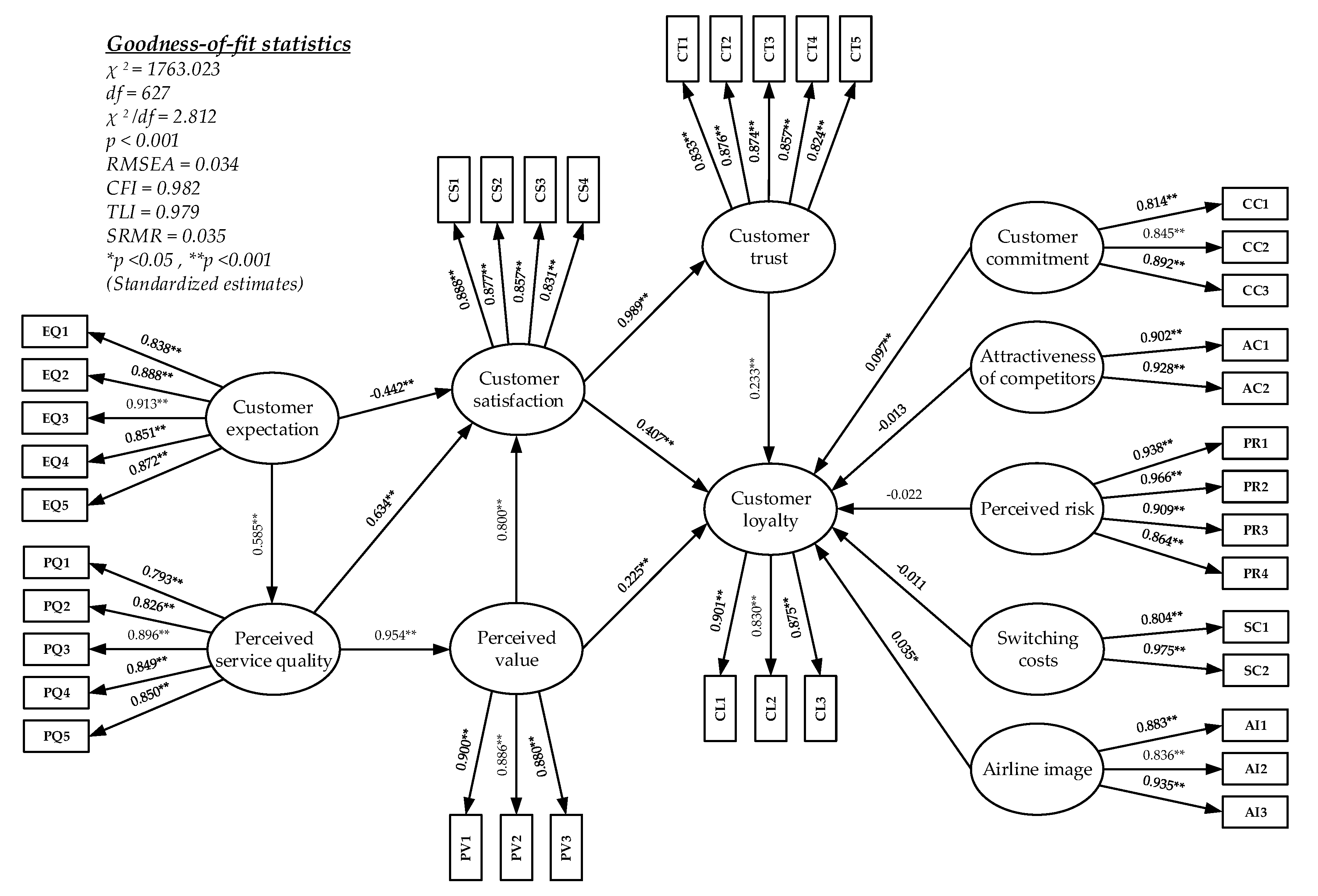
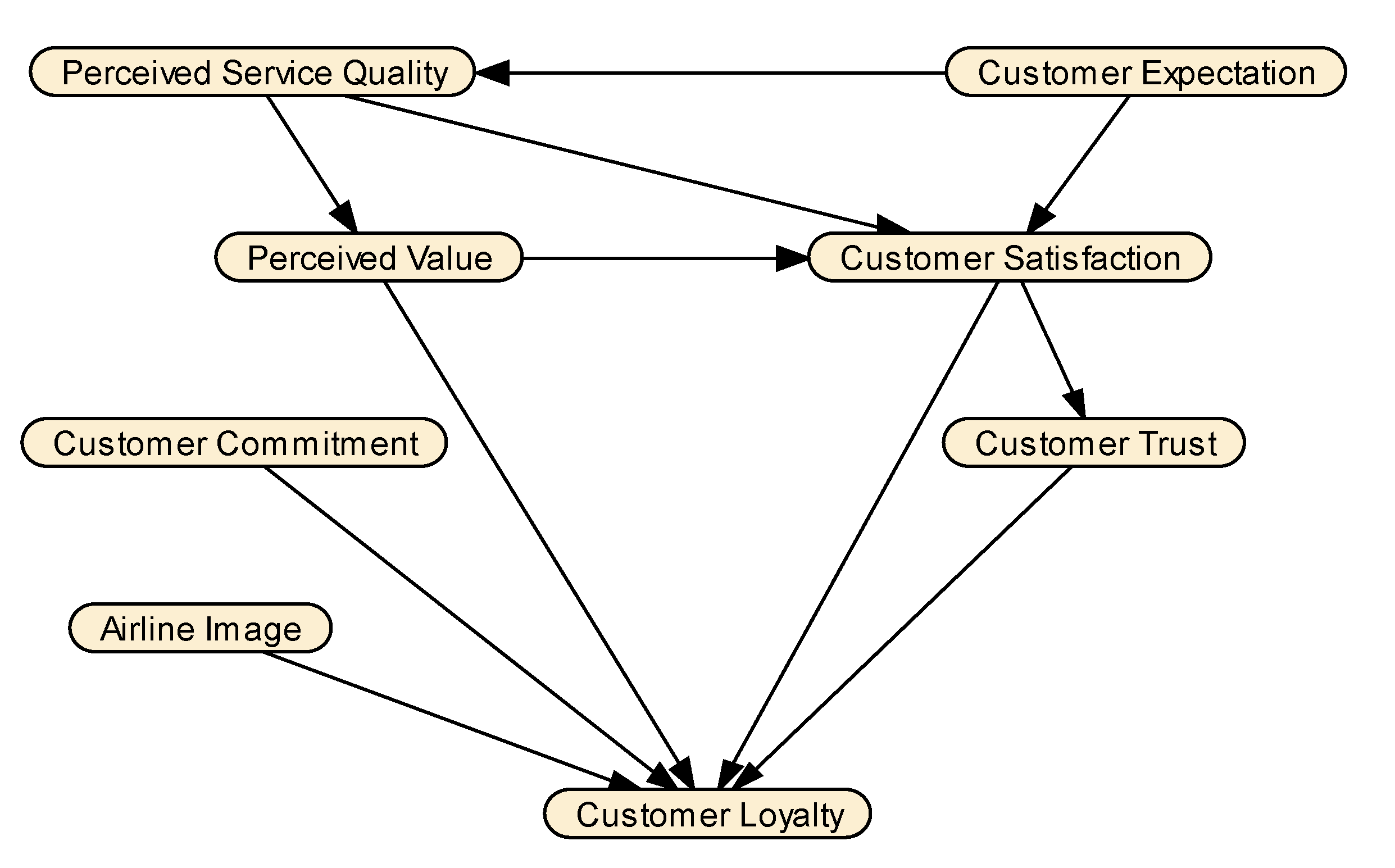
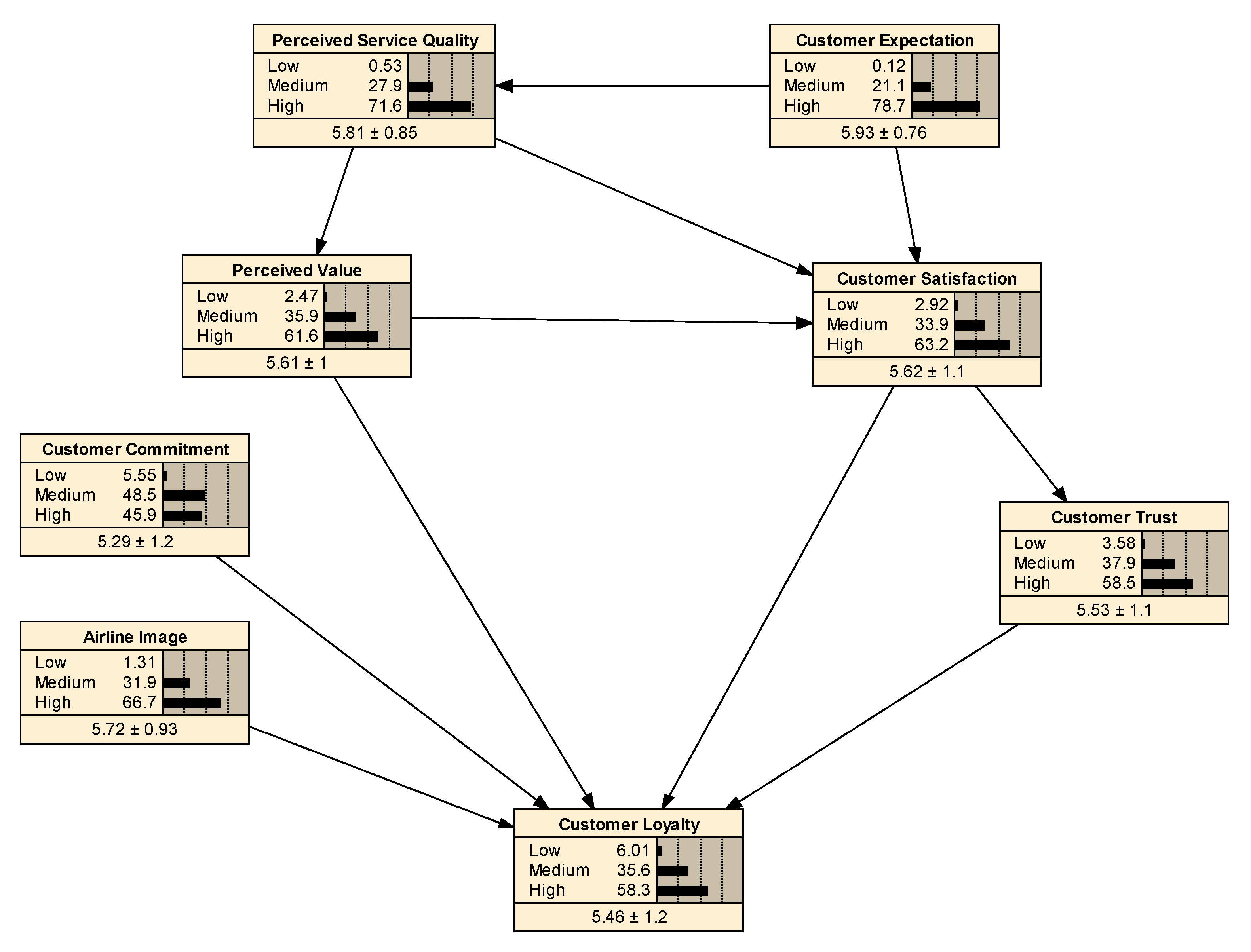
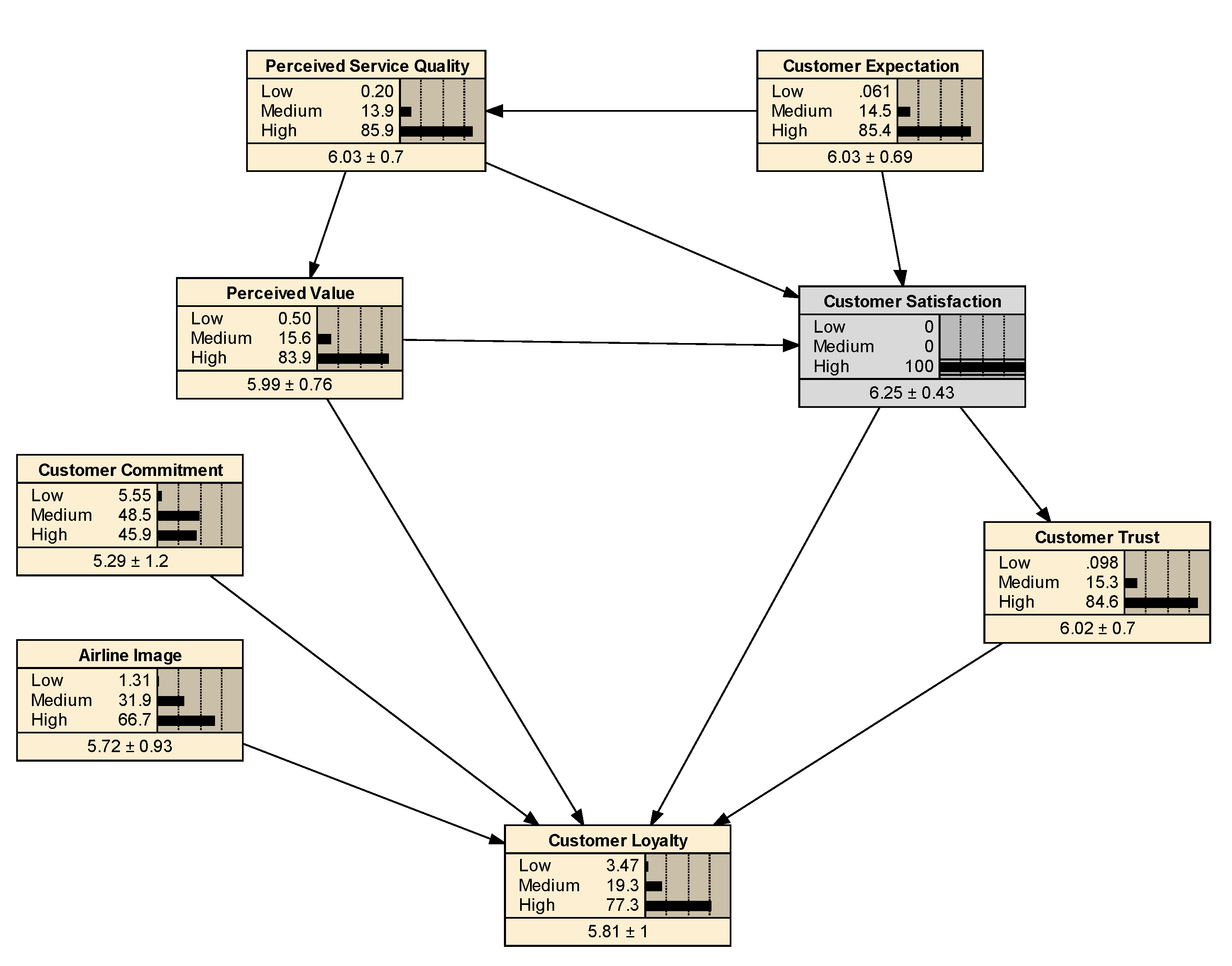
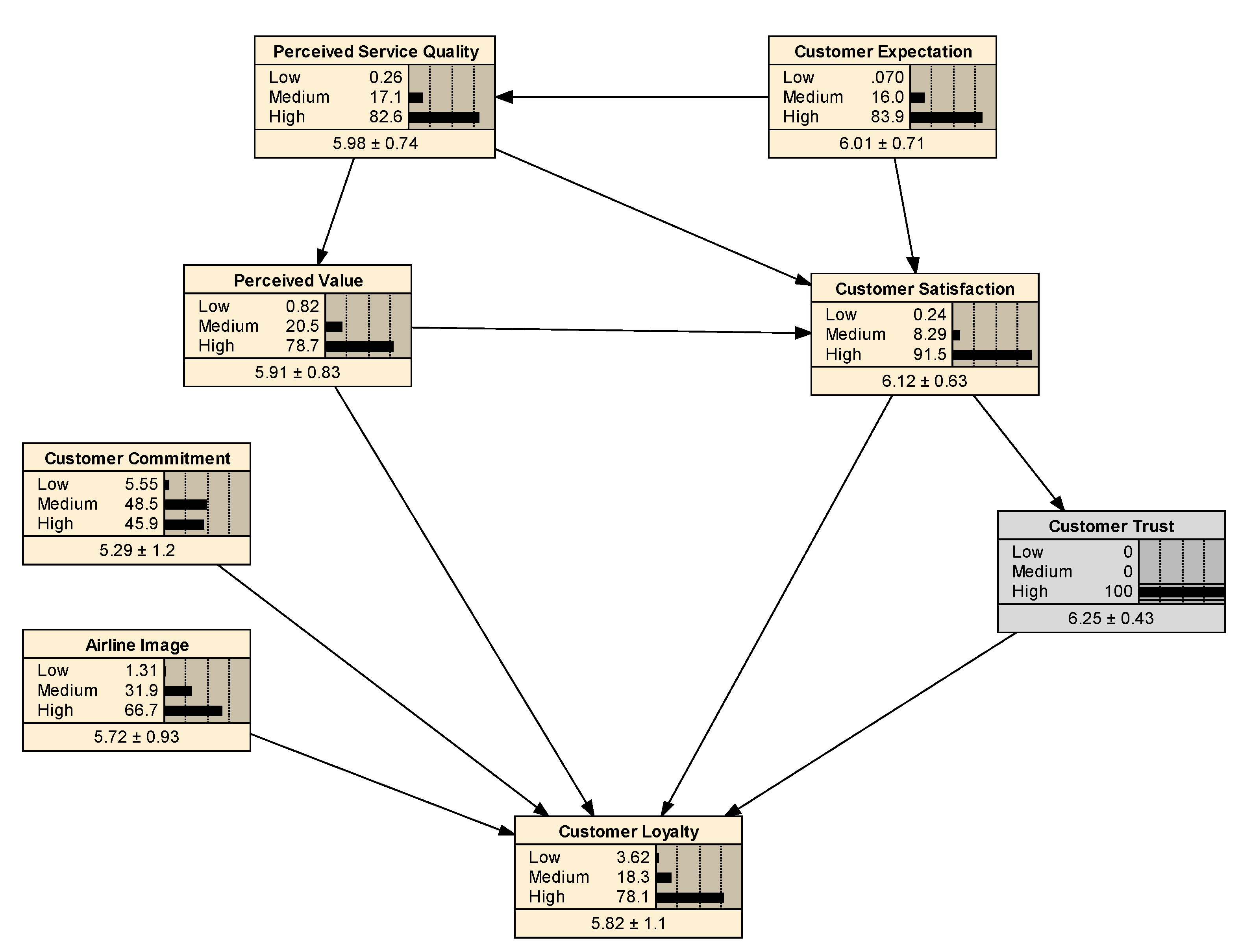
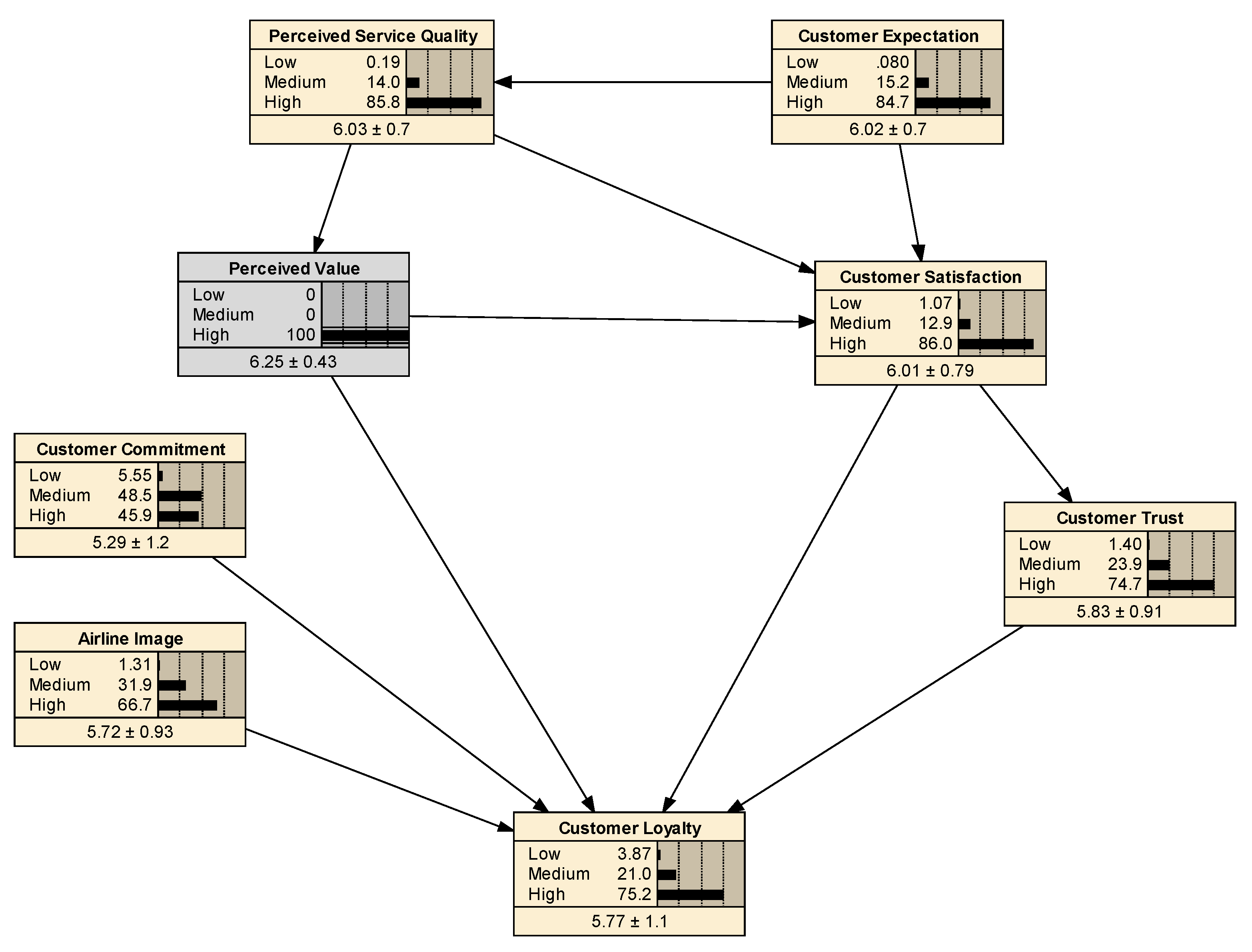

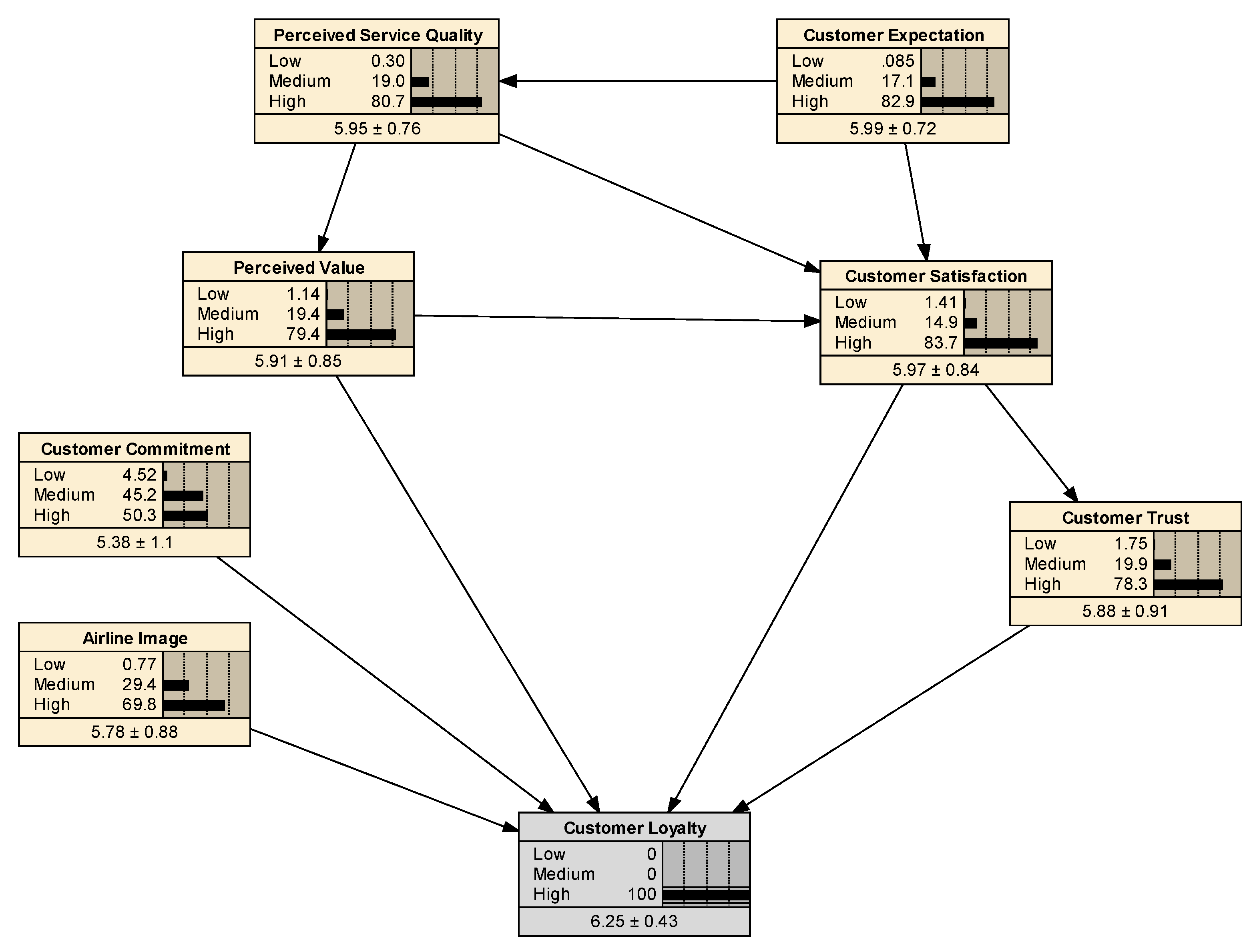
| Actual from Responses | Predicted from the BN | ||
|---|---|---|---|
| Low | Medium | High | |
| Low | 3 | 1 | 0 |
| Medium | 0 | 30 | 4 |
| High | 0 | 5 | 57 |
| Total error rate = 10% | |||
| Factor | Variance Reduction | Percent | Variance of Beliefs |
|---|---|---|---|
| Customer Satisfaction | 0.2306 | 15.2 | 0.0530 |
| Customer Trust | 0.2034 | 13.4 | 0.0485 |
| Perceived Value | 0.1758 | 11.6 | 0.0396 |
| Perceived Service Quality | 0.0538 | 3.54 | 0.0111 |
| Airline Image | 0.0191 | 1.25 | 0.0013 |
| Customer Commitment | 0.0156 | 1.03 | 0.0028 |
| Customer Expectation | 0.0135 | 0.88 | 0.0028 |
| Factor | Mean Value | Change Rate (%) | |
|---|---|---|---|
| Prior | Posterior | ||
| Customer Trust | 5.53 | 5.88 | 6.33 |
| Customer Satisfaction | 5.62 | 5.97 | 6.23 |
| Perceived Value | 5.61 | 5.91 | 5.35 |
| Perceived Service Quality | 5.81 | 5.95 | 2.41 |
| Customer Commitment | 5.29 | 5.38 | 1.70 |
| Airline Image | 5.72 | 5.78 | 1.05 |
| Customer Expectation | 5.93 | 5.99 | 1.01 |
Publisher’s Note: MDPI stays neutral with regard to jurisdictional claims in published maps and institutional affiliations. |
© 2021 by the authors. Licensee MDPI, Basel, Switzerland. This article is an open access article distributed under the terms and conditions of the Creative Commons Attribution (CC BY) license (https://creativecommons.org/licenses/by/4.0/).
Share and Cite
Chanpariyavatevong, K.; Wipulanusat, W.; Champahom, T.; Jomnonkwao, S.; Chonsalasin, D.; Ratanavaraha, V. Predicting Airline Customer Loyalty by Integrating Structural Equation Modeling and Bayesian Networks. Sustainability 2021, 13, 7046. https://doi.org/10.3390/su13137046
Chanpariyavatevong K, Wipulanusat W, Champahom T, Jomnonkwao S, Chonsalasin D, Ratanavaraha V. Predicting Airline Customer Loyalty by Integrating Structural Equation Modeling and Bayesian Networks. Sustainability. 2021; 13(13):7046. https://doi.org/10.3390/su13137046
Chicago/Turabian StyleChanpariyavatevong, Kattreeya, Warit Wipulanusat, Thanapong Champahom, Sajjakaj Jomnonkwao, Dissakoon Chonsalasin, and Vatanavongs Ratanavaraha. 2021. "Predicting Airline Customer Loyalty by Integrating Structural Equation Modeling and Bayesian Networks" Sustainability 13, no. 13: 7046. https://doi.org/10.3390/su13137046
APA StyleChanpariyavatevong, K., Wipulanusat, W., Champahom, T., Jomnonkwao, S., Chonsalasin, D., & Ratanavaraha, V. (2021). Predicting Airline Customer Loyalty by Integrating Structural Equation Modeling and Bayesian Networks. Sustainability, 13(13), 7046. https://doi.org/10.3390/su13137046










